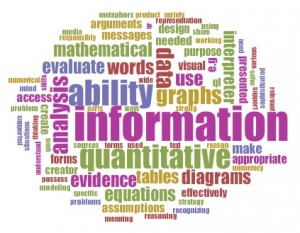UELO: Students will demonstrate information, quantitative, and visual literacies in a variety of contexts.
Principles
Discussion focused on the necessity of integrating these literacies across the curriculum and vertically throughout the curriculum. One course is not enough for a student to develop literacy. Instructors should consider these as threshold concepts rather than skills to be ticked off.
Skills and literacies need context to make them meaningful.
Transfer is important: students need to be able to transfer literacies developed in one course to another course where they can continue development.
Interdisciplinary, project-based learning was suggested as an avenue. This is also a good mission fit: preparing students to be problem solvers and change the world. This kind of interdisciplinary work is a St. Edward’s tradition.
Visual literacy is a 21st century skill. Students work more naturally in images than we did.
We are beyond a text only world. We need to take their natural skill and make it conscious.
We need to develop multiliteracies. See this article: New London Group. “A Pedagogy of Multiliteracies: Designing Social Futures.” Harvard Educational Review 66, no. 1 (1996): 60–92.
The idea isn’t that every class hits every outcome; it should arise naturally.
Concerns and Needs
Students seem to have forgotten literacies learned earlier in the curriculum. We need a common vocabulary. We need campus wide dialogue to work on identifying threshold concepts to equate those terms from different disciplines. For transfer, too often we place the onus on the student; we need to put the onus on us to make sure we know what is going on in other courses so we know to reinforce it.
Instructors need models for how to do this, practices that can be useful across disciplines, and the research behind them. Faculty don’t feel confident in all of this. Will this require huge retraining of the faculty? One participant suggested, we can test all the faculty to know what level of this skill you should be teaching.
These literacies need to be integrated so they come naturally. They can’t be compartmentalized. Students need to see them as an essential learning outcome, rather than a hoop they have to jump through, and then they are done.
Currently, there is a perception that nobody cares about visual literacy. You can’t just check it off for CULF 1319.
Vigor in visual literacy is a challenge because faculty teaching now come from a text-based background. There is no AAC&U rubric for visual literacy; this is a gap we could fill.
It is scary to think that you would need to do all of this one course.
Best Practices
- The development of information literacy requires intense, long-term collaboration with the library rather than one library information session.
- Project-Based Learning: It was suggested that undergraduate research could play a role in achieving these outcomes. Project-based work helps put skills into practice so they are retained.
- Reflection and metacognition plays a huge role in making sure these concepts show up in multiple courses.
- Independent practice:Learners being more inquiry driven on their own, and what do I do when I hit the wall, facilitates research skills, and how do you get what you need, which in turn creates agency.
- Collaborating between faculty to put together courses that pay attention to transfer of literacies.
- Curriculum Mapping: SEU has done curriculum mapping of essential learning outcomes in the general education curriculum. Now, we need to now do it in the majors.
- A multimodal project might tie all of these literacies together.
- Upper level courses team-teaching.
- By senior year massive wicked problem projects.

